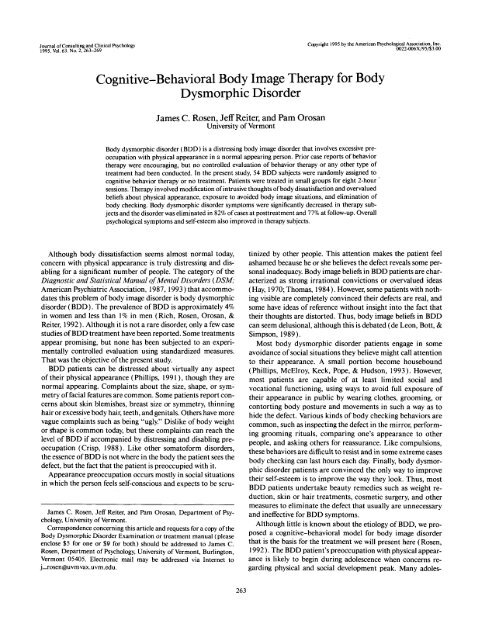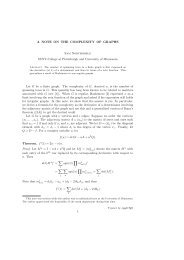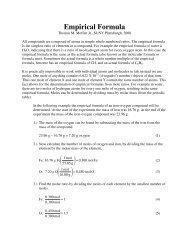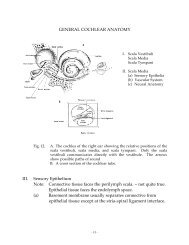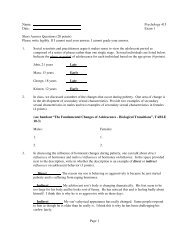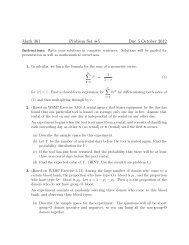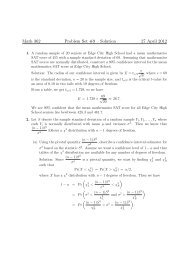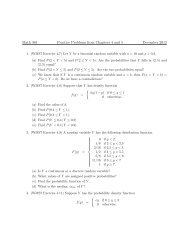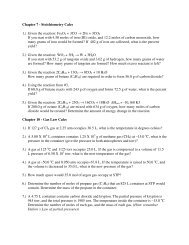Cognitive-Behavioral Body Image Therapy for Body Dysmorphic ...
Cognitive-Behavioral Body Image Therapy for Body Dysmorphic ...
Cognitive-Behavioral Body Image Therapy for Body Dysmorphic ...
You also want an ePaper? Increase the reach of your titles
YUMPU automatically turns print PDFs into web optimized ePapers that Google loves.
Journal of Consulting and Clinical Psychology1995, Vol. 63, No. 2, 263-269Copyright 1995 by the American Psychological Association, Inc.0022-006X/95/S3.00<strong>Cognitive</strong>-<strong>Behavioral</strong> <strong>Body</strong> <strong>Image</strong> <strong>Therapy</strong> <strong>for</strong> <strong>Body</strong><strong>Dysmorphic</strong> DisorderJames C. Rosen, Jeff Reiter, and Pam OrosanUniversity of Vermont<strong>Body</strong> dysmorphic disorder (BDD) is a distressing body image disorder that involves excessive preoccupationwith physical appearance in a normal appearing person. Prior case reports of behaviortherapy were encouraging, but no controlled evaluation of behavior therapy or any other type oftreatment had been conducted. In the present study, 54 BDD subjects were randomly assigned tocognitive behavior therapy or no treatment. Patients were treated in small groups <strong>for</strong> eight 2-hoursessions. <strong>Therapy</strong> involved modification of intrusive thoughts of body dissatisfaction and overvaluedbeliefs about physical appearance, exposure to avoided body image situations, and elimination ofbody checking. <strong>Body</strong> dysmorphic disorder symptoms were significantly decreased in therapy subjectsand the disorder was eliminated in 82% of cases at posttreatment and 77% at follow-up. Overallpsychological symptoms and self-esteem also improved in therapy subjects.Although body dissatisfaction seems almost normal today,concern with physical appearance is truly distressing and disabling<strong>for</strong> a significant number of people. The category of theDiagnostic and Statistical Manual of Mental Disorders (DSM;American Psychiatric Association, 1987, 1993) that accommodatesthis problem of body image disorder is body dysmorphicdisorder (BDD). The prevalence of BDD is approximately 4%in women and less than 1% in men (Rich, Rosen, Orosan, &Reiter, 1992). Although it is not a rare disorder, only a few casestudies of BDD treatment have been reported. Some treatmentsappear promising, but none has been subjected to an experimentallycontrolled evaluation using standardized measures.That was the objective of the present study.BDD patients can be distressed about virtually any aspectof their physical appearance (Phillips, 1991), though they arenormal appearing. Complaints about the size, shape, or symmetryof facial features are common. Some patients report concernsabout skin blemishes, breast size or symmetry, thinninghair or excessive body hair, teeth, and genitals. Others have morevague complaints such as being "ugly." Dislike of body weightor shape is common today, but these complaints can reach thelevel of BDD if accompanied by distressing and disabling preoccupation(Crisp, 1988). Like other somato<strong>for</strong>m disorders,the essence of BDD is not where in the body the patient sees thedefect, but the fact that the patient is preoccupied with it.Appearance preoccupation occurs mostly in social situationsin which the person feels self-conscious and expects to be scru-James C. Rosen, Jeff Reiter, and Pam Orosan, Department of Psychology,University of Vermont.Correspondence concerning this article and requests <strong>for</strong> a copy of the<strong>Body</strong> <strong>Dysmorphic</strong> Disorder Examination or treatment manual (pleaseenclose $5 <strong>for</strong> one or $9 <strong>for</strong> both) should be addressed to James C.Rosen, Department of Psychology, University of Vermont, Burlington,Vermont 05405. Electronic mail may be addressed via Internet toj_rosen@uvm vax.uvm.edu.tinized by other people. This attention makes the patient feelashamed because he or she believes the defect reveals some personalinadequacy. <strong>Body</strong> image beliefs in BDD patients are characterizedas strong irrational convictions or overvalued ideas(Hay, 1970; Thomas, 1984). However, some patients with nothingvisible are completely convinced their defects are real, andsome have ideas of reference without insight into the fact thattheir thoughts are distorted. Thus, body image beliefs in BDDcan seem delusional, although this is debated (de Leon, Bott, &Simpson, 1989).Most body dysmorphic disorder patients engage in someavoidance of social situations they believe might call attentionto their appearance. A small portion become housebound(Phillips, McElroy, Keck, Pope, & Hudson, 1993). However,most patients are capable of at least limited social andvocational functioning, using ways to avoid full exposure oftheir appearance in public by wearing clothes, grooming, orcontorting body posture and movements in such a way as tohide the defect. Various kinds of body checking behaviors arecommon, such as inspecting the defect in the mirror, per<strong>for</strong>minggrooming rituals, comparing one's appearance to otherpeople, and asking others <strong>for</strong> reassurance. Like compulsions,these behaviors are difficult to resist and in some extreme casesbody checking can last hours each day. Finally, body dysmorphicdisorder patients are convinced the only way to improvetheir self-esteem is to improve the way they look. Thus, mostBDD patients undertake beauty remedies such as weight reduction,skin or hair treatments, cosmetic surgery, and othermeasures to eliminate the defect that usually are unnecessaryand ineffective <strong>for</strong> BDD symptoms.Although little is known about the etiology of BDD, we proposeda cognitive-behavioral model <strong>for</strong> body image disorderthat is the basis <strong>for</strong> the treatment we will present here (Rosen,1992). The BDD patient's preoccupation with physical appearanceis likely to begin during adolescence when concerns regardingphysical and social development peak. Many adoles-263
BODY DYSMORPHIC DISORDER 265screened out persons with definite physical abnormalities but includedsubjects with distinctive features who nonetheless were within normallimits (e.g., a large but normally shaped nose). This is consistent withthe DSM and BDD literature. We also included mildly overweight butnot severely overweight subjects (a body mass index between 27.3 and32.3), reasoning that this degree of overweight is common enough (24%of American women according to the NHANESII study; Najjar & Rowland,1987) to consider these subjects normal-looking. Thus, some subjectscomplained of defects that were not completely imagined. However,none had true physical abnormalities and they all perceived theirappearance as being more anomalous and important than was realistic—thatis, they had overvalued ideas.Third, the types of appearance complaints in order of frequency, beginningwith the most frequent, were thighs (38%), abdomen (35%),breast size or shape (20%), skin blemishes (17%), buttocks (15%), facialfeatures (12%), overall weight (9%), scars (8%), aging (7%), hair(7%), height (6%), hips (5%), teeth (4%), and arms (3%). Thirty-eightpercent of subjects presented body weight or shape complaints only,44% presented both weight/shape and other complaints, and 17% presentednon-weight/shape complaints only. By comparison, fewer subjectsin the case series of Phillips et al. (1993) presented weight or shapecomplaints, although half of her cases were men and weight complaintsare less common in men. The significance of the type of appearancecomplaint in BDD is unknown. So far, we have not found any differencein body image and psychological symptoms between BDD patientswhen grouped according to type of appearance complaint, nor is anydifference reported in the BDD literature.Experimental Design and TreatmentSubjects signed a consent to participate prior to the initial evaluationand were randomly assigned to cognitive behavior therapy or no-treatmentcontrol. They were assessed again 2 weeks after the treatment versusno-treatment phase. Subjects in the no-treatment condition subsequentlywere offered therapy, limiting the experimentally controlledportion of the study from pre- to posttreatment. Treatment subjectswere assessed a third time at 4.5 months after treatment. Assessmentswere per<strong>for</strong>med by BA-level research assistants. Eligibility at the initialevaluation was checked by a clinical psychologist. Research assistantswere unin<strong>for</strong>med of the subjects' experimental condition at posttreatmentor follow-up evaluations.No-treatment control. These subjects were promised therapy after aminimum 10-week waiting period.<strong>Cognitive</strong>-behavior therapy. Treatment was provided in groups offour or five patients and one therapist and was scheduled as eight weekly2-hour sessions. If any member of the group was unable to attend asession, the session was canceled and rescheduled. Consequently, thegroups varied in the spacing of treatment sessions, which lasted from 8to 12 weeks. Therapists were the three authors: a clinical psychologistand two post-masters-level graduate students in clinical psychology.Subjects were charged <strong>for</strong> therapy at standard rates.<strong>Therapy</strong> was modeled after the cognitive behavioral body image therapyof Rosen etal. (1989,1990) but was modified to meet the needs of aBDD population (the treatment manual is available from the authors).Subjects were provided with an audiotape program on body image therapyby Thomas Cash (1991) that supported the cognitive-behavioralprinciples used in therapy sessions and structured the homeworkassignments.1. <strong>Therapy</strong> began with an explanation of our model of BDD causationand treatment. Subjects were helped to identify the developmentalantecedents of their body image problem, sociocultural and familialfactors, and the immediate sources of body image distress.2. Subjects explained concretely the distressing aspects of their appearanceto the other members of the group. As much as possible, theywere provided more objective feedback about the appearance of the perceiveddefect. For example, subjects with exaggerated complaints of excessivelylarge thighs or facial features estimated the size or shape of thedistressing part with drawings or moveable markers. These subjectiveperceptions were compared with actual size or shape using anthropometriccalipers or silhouettes drawn by other group members. Subjectsthen rehearsed more accurate representations of their appearancedefects.3. Subjects constructed a hierarchy of distressing aspects of theirappearance. Exposure therapy, thought stopping, and relaxation wereused to extinguish subjective distress at the sight of these features. Thiswas practiced first in therapy sessions when subjects stood in the groupand explained the hierarchy they had constructed while other membersstudied the relevant features of their appearance (subjects did not removetheir clothing). Subjects were taught to refrain from critical selftalkand to substitute more objective sensory descriptions of the bodyparts (e.g., "round nose" instead of "horse face"). Then at home, subjectsprogressed through the hierarchy by exposing themselves firstimaginally and then in front of the mirror, clothed and unclothed. Negativebody talk was to be interrupted with nonjudgmental sensory selfdescription.4. In support of the cognitive therapy, subjects kept a body imagediary throughout treatment in which they recorded relevant situations,the body image thoughts or beliefs they had in these situations, and theeffect of these on mood and behavior. Eventually, subjects were taughtto recognize maladaptive thoughts and to record disputing thoughts inthe diary. We encouraged subjects as much as possible to interrupt intrusivenegative self-statements about the aesthetics of their appearancesuch as, "Oh, my breasts are so limp and shapeless." Ultimately, thesethoughts are difficult to extinguish completely, some degree of body dissatisfactionis normal, and in many cases their self-statements were accurateto some extent. There<strong>for</strong>e, we focused mainly on helping subjectsto correct the more damaging beliefs related to the implications of physicalappearance <strong>for</strong> self-worth and relationships, especially those beliefsthat caused them to feel ashamed or embarrassed around other people.Typically subjects believed their looks proved they were unlovable, foolish,stupid, sluttish, immoral, disgusting, freakish, alien, and so <strong>for</strong>th.5. Exposure therapy was used to overcome distressing self-consciousnessand avoidance of feared body image situations. Exampleexposure assignments were wearing a <strong>for</strong>m-fitting outfit instead ofbaggy clothes, undressing in front of spouse, not hiding facial featureswith hands or combed-down hair, dressing to reveal scars, exercising inpublic wearing work-out clothes, drawing attention to appearance withmore trendy clothes, accentuating a distressing feature (e.g., lips) withmake-up or not wearing make-up at all, standing closer to people, andtrying on clothes or make-up in stores and then asking sales clerks <strong>for</strong>feedback on their looks. Exposure was carried out first in the therapysession, then prescribed as homework. The difficulty of assignments wasincreased by varying the exposure situations with respect to familiarityof people, physical proximity to others, and type of social interaction(e.g., giving a talk in front of a group vs. speaking individually to acolleague; speaking to a superior at work vs. speaking to a friend).6. Response prevention was used to decrease body checking behaviors.Examples are stopping weighing, inspecting in the mirror, or measuringbody size with measuring tapes or certain special clothes. Somesubjects were instructed to set a fixed time <strong>for</strong> dressing or to refrainfrom multiple changes of clothes. Some subjects were instructed to firstaccentuate their desire to check, by messing hair <strong>for</strong> instance, and thento refrain from self-inspection in the mirror. Repeatedly asking otherpeople <strong>for</strong> reassurance and comparing oneself with other people areother <strong>for</strong>ms of body checking that were targeted.7. Finally, subjects were instructed in the principles of relapse pre-
266 J. ROSEN, J. REITER, AND P. OROSANvention and were asked to identify and prepare themselves <strong>for</strong> impendinghigh-risk situations.Measures<strong>Body</strong> <strong>Dysmorphic</strong> Disorder Examination (Version 3.1). This is a32-item semistructured clinical interview designed to measure the cognitiveand behavioral symptoms of body dysmorphic disorder (Rosen &Reiter, 1994). It taps into self-consciousness and preoccupation withphysical appearance, overvalued ideas about the importance of appearancein self-evaluation, avoidance of social situations or exposure of theappearance defects, and body camouflaging and body checking behavior.The BDDE had acceptable test-retest reliability (r = .94), internalconsistency (r = .95), and concurrent validity with other body imagequestionnaires (rs = .68 to .83). The interrater reliability <strong>for</strong> the totalscore of independent interviews was r = .89, and the kappa measure ofindependent diagnostic agreement with the BDDE was .81.For the present study, the BDDE was scored <strong>for</strong> the total severity ofHDD symptoms and <strong>for</strong> the presence or absence of BDD according tothe recommended set of cutoff scores.<strong>Body</strong> Shape Questionnaire. This is a body image questionnaire(Cooper, Taylor, Cooper, & Fairburn, 1987) that measures desire to loseweight, body dissatisfaction, and feelings of low self-worth in connectionwith weight and shape. The coefficients of internal consistency,test-retest reliability, and concurrent validity with other measures ofbody satisfaction are adequate: rs = .97, .88, and .66, respectively.Multidimensional <strong>Body</strong> Self-Relations Questionnaire (MBSRQ) AppearanceEvaluation scale (Brown, Cash, & Mikulka, 1990). Of theseven MBSRQ scales, only the Appearance Evaluation scale was administered.Appearance Evaluation consists of 7 ratings of feelings of physicalattractiveness or unattractiveness and satisfaction or dissatisfactionwith one's looks. The rs <strong>for</strong> test-retest reliability and internal consistencyare .91 and .88. Concurrent validity with another measure ofbody satisfaction is .66.Brief Symptom Inventory (Derogatis & Spencer, 1982). We calculatedthe Global Severity Index, which is an index of overall psychologicaldistress. Test-retest reliability is .90 and internal consistency rangesfrom .71 to .85. Validity coefficients with the Minnesota MultiphasicPersonality Inventory are above .30.Rosenberg Self-Esteem Scale. This is a measure of global self-esteem(Rosenberg, 1979) in vol ving ratings of attitudes regarding generalself-worth. The measure has acceptable test-retest reliability (.77) andinternal consistency (.89). The scale is significantly correlated with peerratings (r= .32; Demo, 1985).PretreatmentResultsStatistical tests per<strong>for</strong>med on values of age, education, bodymass index, marital status, body image measures, psychologicalsymptoms, and self-esteem revealed no significant differencesbetween the experimental conditions at baseline.Adherence, Credibility, and SatisfactionNo subject dropped out of treatment. The cancellation policyproved successful as treatment subjects attended all eight sessions,(i.e., there was 100% attendance). The only deviationfrom the planned <strong>for</strong>mat was that two subjects received one individualsession each because the remainder of group participantswere unable to agree on an alternative meeting time. Ateach session subjects returned a homework completion checklistand the therapists reviewed each assignment. Of the 41homework assignments, subjects completed an average of 86%(SD = 15). Twenty-two percent completed less than 80% ofassignments, but none completed less than half. All subjectscompleted the posttreatment (or postwaiting) evaluation. Onetreatment subject refused to return <strong>for</strong> the follow-up evaluation.No treatment subject began psychological treatment outside ofthe program during the treatment or follow-up phase. One notreatmentsubject started psychotherapy elsewhere 2 weeksprior to the posttreatment assessment.In the second therapy session, we asked subjects to rate on ascale of 1 to 7 their expectation to benefit from this therapy; themean was 5.46 (SD = .90). After treatment ended, their ratingof satisfaction with treatment was 5.73 (SD = 1.22) and thedegree to which they would recommend this program to otherswas 6.27 (SD = 1.31). Eighty percent said they would recommendthe program. These ratings and the percent of homeworkcompletion were not significantly correlated with changes onthe body image measures.To assist therapist adherence to the treatment protocol, therapistsfollowed a detailed session-by-session manual. Con<strong>for</strong>mityalso was simplified by the fact that a main focus of eachsession was debriefing and preparing <strong>for</strong> the homework assignments,which were fairly standard <strong>for</strong> all subjects. Finally, thethree therapists met weekly to review each case and ensure adherenceto the protocol.Differences Between Conditions at PosttreatmentThe difference between the treatment and no-treatment conditionsat posttreatment on the five measures of body imageand psychological adjustment (see Table 1) was examined in abetween-groups multivariate analysis of covariance, controlling<strong>for</strong> pretreatment scores. The main effect <strong>for</strong> group was significant,F(5, 43) = 20.01, p = .000, indicating that the subjectswho received treatment were much improved compared withthe no-treatment subjects.Differences between groups at posttreatment on individualdependent variables controlling <strong>for</strong> pretreatment were examinedusing the univariate analyses of covariance derived fromthe multivariate analysis. <strong>Cognitive</strong> behavior therapy subjectswere significantly improved on all measures at posttreatmentcompared with the no-treatment subjects: <strong>Body</strong> <strong>Dysmorphic</strong>Disorder Examination, F( 1, 47) = 65.80, p = .000; MBSRQAppearance Evaluation scale, F( 1,47) = 45.57,p = .000; <strong>Body</strong>Shape Questionnaire, F( 1,47) = 81.61, p = .000; psychologicalsymptoms, F( 1, 47) = 13.53, p = .001; and self-esteem, F( 1,47)= 12.61, p= . 001.Differences Over Time <strong>for</strong> <strong>Cognitive</strong> Behavior <strong>Therapy</strong>ParticipantsA within-subject multivariate analysis of variance (MANO\A)using the pre-, posttreatment, and follow-up assessments resultedin a main effect <strong>for</strong> time, F( 10, 16) = 11.09, p = .000, indicatingthat treatment subjects were significantly improved over time.Univariate analyses derived from the MANOVA resulted in sig-
BODY DYSMORPHIC DISORDER 267Table 1Means and Standard Deviations of Dependent Variables by Treatment Phase<strong>Cognitive</strong>-behaviortherapy(n = 27)'No treatment(n = 27)MeasureMSDMSD<strong>Body</strong> <strong>Dysmorphic</strong> Disorder ExamPretreatmentPosttreatmentFollow-upMBSRQ Appearance Evaluation ScalePretreatmentPosttreatmentFollow-up<strong>Body</strong> Shape QuestionnairePretreatmentPosttreatmentFollow-upBrief Symptom InventoryPretreatmentPosttreatmentFollow-upRosenberg Self-Esteem ScalePretreatmentPosttreatmentFollow-up83.941.139.91.973.082.99133.587.588.0.92.57.5025.129.930.014.816.921.3.42.59.8219.220.422.8.48.46.405.65.65.2Note. MBSRQ = Multidimensional <strong>Body</strong> Self-Relations Questionnaire.• At follow-up, N = 26.89.983.2—1.861.85—142.7142.4—1.01.0—23.924.9—16.119.7—.39.59—24.626.3—.53.60—4.75.9—nificant main effects <strong>for</strong> time <strong>for</strong> each variable (df= 2,49; p =.000): <strong>Body</strong> <strong>Dysmorphic</strong> Disorder Examination, F(2, 49) =69.02, p = .000; MBSRQ Appearance Evaluation Scale, F(2,49)= 31.89, p = .000; <strong>Body</strong> Shape Questionnaire, F( 2,49) = 57.55,p = .000; psychological symptoms, F(2, 49) = 17.59, p = .000;and self-esteem, F(2,49) = 28.23, p = .000.Post hoc paired comparisons controlling <strong>for</strong> family-wise errorindicated that treatment subjects improved significantly onall measures from pre- to posttreatment and pretreatment tofollow-up at p = .000, except that the pre- to posttreatmentchange in psychological symptoms was significant at p = .003.There were no significant differences between posttreatmentand follow-up.Rates of Clinically Significant ImprovementTo be considered clinically improved, a subject had to (a)no longer meet the diagnostic criteria on the <strong>Body</strong> <strong>Dysmorphic</strong>Disorder Examination and (b) have a score lower on the BDDEafter treatment than her pretreatment score minus 2 standarderrors of measurement. Using Speer's recommendation <strong>for</strong> calculatingclinically significant change (1992), we centered thisconfidence interval on an estimate of the subject's "true" pretreatmentscore, which adjusted <strong>for</strong> regression to the mean. Twosubjects in the no-treatment condition (7.4%) met these criteria<strong>for</strong> improvement after the waiting period. Of the 27 cognitivetherapy subjects, 22 were clinically improved at posttreatment(81.5%) and 20 of 26 were improved at follow-up (76.9%).Three of the five unimproved treatment subjects at posttreatmentwere clinically improved at follow-up, and four "relapsed,"that is, no longer scored in the clinically improvedrange at follow-up.Discussion<strong>Cognitive</strong> behavioral body image therapy proved to be aneffective treatment <strong>for</strong> body dysmorphic disorder. The total severityof BDD symptoms of therapy subjects decreased to thenormal range on the <strong>Body</strong> <strong>Dysmorphic</strong> Disorder Examination(.4 SD above the mean <strong>for</strong> a community sample, Rosen &Reiter, 1993) and the majority of patients no longer met thediagnostic criteria <strong>for</strong> BDD. Preoccupation with appearanceand body dissatisfaction were improved on the other two measuresof body image, the <strong>Body</strong> Shape Questionnaire andMBSRQ Appearance Evaluation scale. The means on thesescales decreased from the clinically severe range to the normalrange. Although other psychological symptoms were nottargeted in therapy, on average the total severity of symptomsand global self-esteem improved to the normal range.Treatment was not uni<strong>for</strong>mly effective; a significant minorityof subjects still had BDD at the follow-up. We were unable toidentify any subject characteristics that distinguished these patientsfrom others. They did not differ in demographics or severityof body image and psychological symptoms at baseline.However, in regard to the therapy <strong>for</strong>mat, our impression wasthat some patients might have benefitted from longer treatmentand more intensive, supervised exposure response preventionoutside of the clinic. Also, it is possible that some subjects might
268 J. ROSEN, J. REITER, AND P. OROSANhave benefitted from more individual attention than allowed ingroup therapy. On the other hand, none of the subjects complainedof this, and actually, there seemed to be advantages ofthe group <strong>for</strong>mat. Our impression was that the patients inspiredeach other to complete homework and invest themselves in therapyat times when they felt like dropping out. Moreover, itseemed therapeutic <strong>for</strong> the subjects to observe other womenconquer the same type of maladaptive beliefs about appearanceand self-worth that they held themselves.The successful outcome is consistent with previous reports ofcognitive behavior therapy <strong>for</strong> BDD (Marks & Mishan, 1988;Neziroglu & Yaryura-Tobias, 1993b). The additional contributionsof this study were that a larger series of patients was studied,subjects received no treatment <strong>for</strong> BDD other than cognitivebehavior therapy, therapy was more effective than a controlcondition of repeated assessment, more subjects with weightand shape complaints were included, and outcome was evaluatedwith standardized measures of body image and BDDsymptoms. The effectiveness of this body image therapy alsois similar to the results we obtained earlier with women whoreported less severely disturbed body image than BDD (Rosenet al., 1989, 1990). Thus, it seems that cognitive behavioralbody image therapy is appropriate <strong>for</strong> persons with different degreesof body image disorder.Although this study was very encouraging, we hope it will bejust a beginning to more systematic controlled treatment trials<strong>for</strong> BDD, a disorder that has been surprisingly neglected. Thereare several limitations and new questions in this project thatcould be addressed in future research. One research design limitationwas the lack of experimental control carried out to afollow-up period. Thus, the longer term effect of treatment versusno treatment remains to be evaluated. The length of ourfollow-up was short and because there was some deteriorationin the improvement after treatment; a much longer follow-up isneeded. The experimental design controlled <strong>for</strong> treatment butnot <strong>for</strong> attention and nonspecific aspects of therapy. Thus, aplacebo control in BDD treatment research might be worthevaluating, although we have found this type of intervention tobe ineffective <strong>for</strong> people with body image problems (Rosen etal., 1989). The encouraging results in this study cannot necessarilybe generalized to male BDD patients. Also the effectivenessof this type of cognitive behavioral body image therapy <strong>for</strong>strictly non-weight or shape complaints is unknown. Althoughwe could find no difference in treatment outcome based on typeof appearance complaint, our sample of non-weight/shapecomplainers was too low to give a definitive answer to this question.Finally, the only other treatment <strong>for</strong> BDD that has beenrecommended is pharmacotherapy, especially the use of serotoninreuptake blockers (Phillips, 1991). Thus, it would be usefulto compare these two modalities in a single study and to evaluatethe use of combined treatment.ReferencesAmerican Psychiatric Association. (1987). Diagnostic and statisticalmanual of mental disorders-revised (3rd ed.). Washington, DC:Author.American Psychiatric Association. (1993). DSM-IVdraft. Washington,DC: Author.Bloch, S., & Glue, P. (1988). Psychotherapy and dysmorphophobia: Acase report. British Journal of Psychiatry, 152, 271-274.Braddock, L. E. (1982). Dysmorphophobia in adolescence: A case report.British Journal of Psychiatry, 140, 199-201.Brown, T. A., Cash, T. F, & Mikulka, P. J. (1990). Attitudinal bodyimageassessment: Factor analysis of the <strong>Body</strong> Self-Relations Questionnaire.Journal of Personality Assessment, 35, 134-144.Butters, J. W., & Cash, T. F. (1987). <strong>Cognitive</strong>-behavioral treatment ofwomen's body-image dissatisfaction. Journal of Consulting and ClinicalPsychology, 55, 889-897.Cash, T. F. (1991). <strong>Body</strong> image therapy: A program <strong>for</strong> self-directedchange [Audiocassette series including client workbook]. New York:Guil<strong>for</strong>d.Cooper, Z., & Fairburn, C. G. (1987). The Eating Disorder Examination:A semi-structured interview <strong>for</strong> the assessment of the specificpsychopathology of eating disorders. International Journal of EatingDisorders, 6, 1-8.Cooper, P. J., Taylor, M. J., Cooper, Z., & Fairburn, C. G. (1987). Thedevelopment and validation of the <strong>Body</strong> Shape Questionnaire. InternationalJournal of Eating Disorders, 6, 485-494.Crisp, A. H. (1988). Some possible approaches to prevention of eatingand body weight/shape disorders, with particular reference to anorexianer\osa. International Journal of Eating Disorders, 7, 1-17.Demo, D. H. (1985). The measurement of self-esteem: Refining ourmethods. Journal of Personality and Social Psychology, 48, 1490-1502.Derogatis, L. R., & Spencer, P. M. (1982). The Brief Symptom Inventory:Administration, scoring, and procedures manual. Baltimore,MD: Clinical Psychometric Research.Dworkin, S. H., & Kerr, B. A. (1987). Comparison of interventions <strong>for</strong>women experiencing body image problems. Journal of CounselingPsychology, 34, 136-140.de Leon, J., Bott, A., & Simpson, G. M. (1989). Dysmorphophobia:<strong>Body</strong> dysmorphic disorder of delusional disorder, somatic subtype?Comprehensive Psychiatry, 30, 457-472.Giles, T. R. (1988). Distortion of body image as an effect of conditionedfear. Journal of Behaviour <strong>Therapy</strong> and Experimental Psychiatry, 19,143-146.Grant, J. R., & Cash, T. F (in press). <strong>Cognitive</strong>-behavioral body-imagetherapy: Comparative efficacy of group and modest-contact treatments.Behavior <strong>Therapy</strong>.Hay, G. G. (1970). Dysmorphophobia. British Journal of Psychiatry,116, 399-406.Hollander, E., Liebowitz, M. R., Winchel, R., Klumer, A., & Klein,D. F. (1989). Treatment of body-dysmorphic disorder with serotoninreuptake blockers. American Journal of Psychiatry, 146, 768-770.Hollander, E., Neziroglu, F. A., Phillips, K. A., & Rosen, J. C. (1992,November). <strong>Body</strong> <strong>Dysmorphic</strong> Disorder. Symposium conducted atthe meeting of the Association <strong>for</strong> Advancement of Behavior <strong>Therapy</strong>,Boston.Marks, I., & Mishan, J. (1988). Dysmorphophobic avoidance with disturbedbodily perception: A pilot study of exposure therapy. BritishJournal of Psychiatry, 152, 674-678.Munjack, D. J. (1978). The behavioral treatment of dysmorpnobia.Journal Behavior <strong>Therapy</strong> and Experimental Psychiatry, 9, 53-56.Najjar, M. F., & Rowland, M. (1987). Anthropometric reference dataand prevalence of overweight: United States, 1976-80. Vital & HealthStatistics, 238, (Series 11).Neziroglu, F. A., & Yaryura-Tobias, J. A. (1993a). <strong>Body</strong> dysmorphicdisorder: Phenomenology and case descriptions. Behavioural Psychotherapy,21, 27-36.Neziroglu, F. A., & Yaryura-Tobias, J. A. (1993b). Exposure, response
BODY DYSMORPHIC DISORDER 269prevention, and cognitive therapy in the treatment of body dysmorphicdisorder. Behavior <strong>Therapy</strong>, 24, 431-438.Philippopoulos, G. S. (1979). The analysis of a case of dysmorfophobia.Canadian Journal of Psychiatry, 24, 397-401.Phillips, K. A. (1991). <strong>Body</strong> dysmorphic disorders: The distress ofimagined ugliness. American Journal of Psychiatry, 148, 1138-1149.Phillips, K. A., McElroy, S. L., Keck, P. E., Pope, H. G., & Hudson, J. I.(1993). <strong>Body</strong> dysmorphic disorder: 30 cases of imagined ugliness.American Journal of Psychiatry, ISO, 302-308.Rich, N., Rosen, J. C., Orosan, P. G., & Reiter, J. T. (1992, November).Prevalence of body dysmorphic disorder in non-clinical populations.Paper presented at the meeting of the Association <strong>for</strong> Advancementof Behavior <strong>Therapy</strong>, Boston.Rosen, J. C. (1992). <strong>Body</strong> image disorder: Definition, development, andcontribution to eating disorders. In J. H. Crowther, D. L. Tennenbaum,S. E. Hobfoll, & M. A. P. Stephens (Eds.), The etiology ofbulimia: The individual and familial context (pp. 157-177). Washington,DC: Hemisphere.Rosen, J. C., Cado, S., Silberg, S., Srebnik, D., & Wendt, S. (1990).<strong>Cognitive</strong> behavior therapy with and without size perception training<strong>for</strong> women with body image disturbance. Behavior <strong>Therapy</strong>, 21,481 -498.Rosen, J. C., & Reiter, J. (1994). Development of the <strong>Body</strong> <strong>Dysmorphic</strong>Disorder Examination. Manuscript submitted <strong>for</strong> publication.Rosen, J. C., Saltzberg, E., & Srebnik, D. (1989). <strong>Cognitive</strong> behaviortherapy <strong>for</strong> negative body image. Behavior <strong>Therapy</strong>, 20, 393-404.Rosenberg, M. (1979). Conceiving the self. New York: Basic Books.Speer, D. C. (1992). Clinically significant change: Jacobson and Truax(1991) revisited. Journal of Consulting and Clinical Psychology, 60,402-408.Thomas, C. S. (1984). Dysmorphophobia: A question of definition.British Journal of Psychiatry, 144, 513-516.Vitiello, B., & de Leon, J. (1990). Dysmorphophobia misdiagnosed asobsessive-compulsive disorder. Psychosomatics, 31, 220-221.Received August 24, 1993Revision received April 8, 1994Accepted April 11,1994 •MEMBERS OF UNDERREPRESENTED GROUPS:REVIEWERS FOR JOURNAL MANUSCRIPTS WANTEDIf you are interested in reviewing manuscripts <strong>for</strong> APA journals, the APA Publications and CommunicationsBoard would like to invite your participation. Manuscript reviewers are vital to thepublication process. As areviewer, you would gain valuable experience in publishing. The P&C Boardis particularly interested in encouraging members of underrepresented groups to participate more in thethis process.If you are interested in reviewing manuscripts, please write to Leslie Cameron at the address below.Please note the following important points:• To be selected as a reviewer, you must have published articles in peer-reviewed journals. Theexperience of publishing provides a reviewer with the basis <strong>for</strong> preparing a thorough, objectivereview.• To select the appropriate reviewers <strong>for</strong> each manuscript, the editor needs detailed in<strong>for</strong>mation.Please include with your letter your vita. In your letter, please identify which APA journal youare interested in and describe your area of expertise. Be as specific as possible. For example,"social psychology" is not sufficient—you would need to specify "social cognition" or "attitudechange" as well.• Reviewing a manuscript takes time. If you are selected to review a manuscript, be prepared toinvest the necessary time to evaluate the manuscript thoroughly.Write to Leslie Cameron, Journals Office, American Psychological Association, 750 First Street, NE,Washington, DC 20002-4242.


